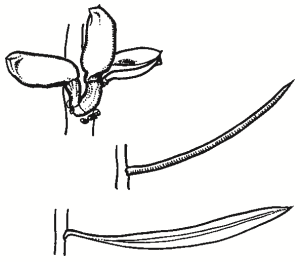Family:
Proteaceae
Hakea microcarpa
Small-fruited Hakea
(syn. H. patula, H. bifrons, H. glabriflora)
Other Names: Small-fruit Hakea
First Nations Name(s):

Name Origin:
Hakea — after Baron Christian L. von Hake, 18-19th century German patron of botany.
microcarpa — from Greek micro, small, and carpos, fruit, referring to small fruit.
Regional Subspecies:
Occurrence:
Regional:
Noted only in Munderoo district. Possibly also in surrounding areas in similar country.
Australia:
Qld, NSW, Vic, Tas.
Habitat:
Wet situations in dry sclerophyll forest and woodland, including streamsides and bogs, or heathy swamps, mainly at higher altitudes.
Habit:
Small, rigid, open, spreading shrub to 2 m high. Cylindrical or flattened leaves 3-11 cm long on erect branches.
Site Preference:
Wet areas. Tolerates frost.
Flowering:
Creamy-white, spring-early summer. Conspicuous.
Seed Collection:
Monitor closely as seeds shed 3-14 days after maturity. Ensure collection by securing nylon stockings or paper bags over seed pods. Large quantities generally available.
Propagation:
From seed. Germinates readily from fresh seed. Suitable for direct seeding into pots.
VALUES:
Shade & Shelter:
Useful low-level cover in windbreaks in poorly drained sites.
Land Protection:
Useful for improving drainage in wet sites.
Wildlife:
Flowers are a food source for native insects. Foliage good refuge for small birds.
Ornamental:
Attractive, particularly when flowering or with open fruits. Easily cultivated. Prune regularly to promote branching.
